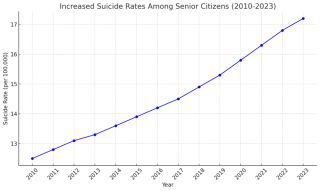Aging
Problems in the Golden Years—Longevity Versus Reality
A look at suicide, loneliness, pain, substance abuse, and STIs in older age.
Updated July 2, 2024 Reviewed by Michelle Quirk
Key points
- Seniors have a disproportionately high rate of suicide, largely due to social isolation and depression.
- Increasing numbers of seniors misuse prescriptions and use alcohol and cannabis to cope with chronic pain.
- Cannabis may increase risks for drug interactions, falls, and depression.

Life today for a person aged 65 years or older dramatically differs from life 50 years ago, with major advances in health and technology. Futurists like Ray Kurzweil predict continued advances in biotechnology, nanotechnology, and artificial intelligence, which could lead to increases in life expectancy. Scientific advancements may allow people to live beyond 100 years. On the other hand, many older adults face social isolation, chronic pain, shrinking social networks, and the deaths of loved ones. Physical, emotional, and cognitive struggles may lead to major depression, often underdiagnosed and undertreated in older adults. Adults over 65 account for almost 17 percent of suicides in the United States, although representing 12 percent of the population. Self-medication among older adults is increasing, and nearly 10 percent have a substance use disorder (SUD).
Suicide
Stanford University Professor Dr. Keith Humphreys, told me, “Our research showed the rate of drug-involved suicides among older Americans has increased by 60% since 2001. This should be a major concern for older people as well as their doctors.” Men aged 85 years and older had the highest suicide rate, while women aged 55 to 64 years had the highest rate.

It’s also true Americans aged 65 years and older are at higher risk for completing suicide (dying) than other age groups. For example, one in 200 youths attempting suicide completes it, compared to one in four older adults.
Possible Reasons for Suicide and/or Substance Abuse
The Centers for Disease Control and Prevention (CDC) says social isolation or chronic pain may increase suicide risks among older people. For example, nearly a third (30 percent) of those aged 65 to 84 years experience chronic pain. According to the CDC, the U.S. suicide rate reached a historic high in 2022. The CDC also reports that 46 percent of people dying by suicide were previously diagnosed with a mental health condition such as depression. One in four deaths by suicide involves alcohol. People aged 75 years and older had the highest suicide rate among all age groups, largely driven by males.
Social Isolation
Approximately one-quarter of community-dwelling Americans aged 65 years and older are socially isolated, and many report loneliness. Social isolation is linked with a 50 percent increased risk of depression, dementia, and premature death from all causes, equal to known risks like smoking, obesity, and physical inactivity.
In 2024, the National Council on the Aging reported that suicide is a hidden epidemic among older adults and stated
- In 2022, among nearly 50,000 suicides in the United States, 10,433 were attributed to people aged 65 years or older.
- Older adults plan suicide more carefully and are likely to use more lethal methods.
Loneliness is associated with higher rates of depression, anxiety, and suicide. Loneliness among heart failure patients is associated with nearly four times increased risk of death, 68 percent increased risk of hospitalization, and 57 percent increased risk of emergency department visits.
Seniors and Substance Use

Professor of Neurology and Psychiatry Josepha Cheong, MD, said “It's an established fact pain and medications used to address pain can have a negative impact on mental health issues such as anxiety and depression. On the other hand, chronic and untreated pain contribute to erosion of well-being and mental health and deterioration of daily function of any individual, especially older adults.” Self-medication of undiagnosed and untreated depression with alcohol, benzodiazepines, and marijuana is common among older adults. These substances often fail to provide relief and may worsen depression, adding a new problem, addiction, to depression.
Cannabis use
Access to cannabis (“medical marijuana”) has added to potential substance options. Americans over 65 who used marijuana nearly tripled in a decade. Cannabis use for many older Americans is less about getting high and more about self-medicating arthritic joints, getting sleep, and soothing aching backs and necks. Of older adults who use cannabis, approximately 75 percent say they use it for medical purposes. Harvard-Beth Israel Chief of Addiction Psychiatry Kevin Hill, MD, MHS, told me, “Senior citizens are a complex group with comorbid medical conditions and often multiple medications. Cannabis is a complex plant with a host of potential adverse effects. As a result, combining senior citizens with cannabis is a risky proposition that underscores the importance of talking with your doctor if you are thinking about using cannabis or other cannabinoids for a medical condition.”
Alcohol Use Disorders
About 12 percent of seniors have an alcohol use disorder. Substance use in older people can complicate medical management, interfere with prescriptions, and increase health problems, fall risks, injuries, and accidents.
More than 900,000 seniors nationwide abuse alcohol. Alcohol accounted for 11,616 deaths among seniors in 2020, an 18 percent increase over the previous year. Older Medicare beneficiaries with substance use disorders were more than three times as likely to report “serious psychological distress” as those without such disorders. About 7 percent had suicidal thoughts, compared with 2 percent who didn’t report substance disorders. Yet very few of these seniors underwent treatment in the past year or even sought treatment.
Fatal Overdoses
Fatal drug overdoses have soared among seniors. From 2002 to 2021, the rate of overdose deaths quadrupled to 12 per 100,000 from 3 per 100,000, Dr. Humphreys reported in JAMA Psychiatry. Most substance use disorders among older people involve prescribed medications, not illegal drugs. Since most Medicare beneficiaries take multiple drugs, “It’s easy to get confused,” Dr. Humphreys said. “The more complicated the regimen, the easier to make mistakes. And then you have an overdose.” Alcohol also plays a major role in overdoses.
Risky Sexual Behaviors
Risky sexual behaviors have increased in seniors. More than half of men and 31 percent of women aged 65 to 80 years are sexually active. Alcohol and drug use impair judgment, leading to unsafe sex practices, such as not using condoms to protect against sexually transmitted infections (STIs). Recent CDC reports indicate increases in syphilis, gonorrhea, and chlamydia among older adults.
High numbers of widowed and divorced people, pharmacological treatment for erectile dysfunction, and women outliving men have led to more sex partners. A key issue: Many older people think the only reason for condoms is preventing pregnancy. In one study by AARP, only 8 percent of older sexually active individuals in the past month used condoms all the time. In another study, 3 percent of people aged 60 years and older used condoms in the past year. Physicians routinely ask young people about their sexual history and screen for STIs and should do the same for older adults.
Summary
It is a crisis, but Dr. Cheong advised, “Everyone can help! Geriatric psychiatrists (and clinicians in general) should screen all older people for suicidal thoughts and depression and adjust medications for those on pain medications or benzodiazepines and also consider alternatives to medication-based treatment of pain. The government can mandate the education of all prescribers on the increased risks associated with the misuse/abuse of opioids and benzodiazepines. Family and friends should monitor changes in behavior and mood in older adults such as increasing isolation and social withdrawal, decreasing overall self-care, loss of interest in usual activities, negative attitude, and irritability.”
Many people are unaware older individuals are at increased risk for loneliness, depression, anxiety, substance use disorders, STIs, and suicide. Without expert help, older individuals increasingly turn to alcohol, cannabis, or prescriptions for pain, insomnia, mood, or anxiety problems.
If you or someone you love is contemplating suicide, seek help immediately. For help 24/7, dial 988 for the 988 Suicide & Crisis Lifeline, or reach out to the Crisis Text Line by texting TALK to 741741. To find a therapist near you, visit the Psychology Today Therapy Directory.
References
Humphreys K, Shover CL. Twenty-Year Trends in Drug Overdose Fatalities Among Older Adults in the US. JAMA Psychiatry. 2023 May 1;80(5):518–520. doi: 10.1001/jamapsychiatry.2022.5159. PMID: 36988923; PMCID: PMC10061315.
Balachandran P, Elsohly M, Hill KP. Cannabidiol Interactions with Medications, Illicit Substances, and Alcohol: a Comprehensive Review. J Gen Intern Med. 2021 Jul;36(7):2074–2084. doi: 10.1007/s11606-020-06504-8. Epub 2021 Jan 29. PMID: 33515191; PMCID: PMC8298645.
Schepis TS, Simoni-Wastila L, McCabe SE. Prescription opioid and benzodiazepine misuse is associated with suicidal ideation in older adults. Int J Geriatr Psychiatry. 2019; 34(1): 122–129. doi: 10.1002/gps.4999
Walaszek A. Optimizing the Treatment of Late-Life Depression. Am J Psychiatry. 2024 Jan 1;181(1):7–10. doi: 10.1176/appi.ajp.20230919. PMID: 38161301.




